Groovebox Roundup: How Do These Beat Machines Stack Up?
Seemingly out of nowhere, electronic producers looking to take their music beyond their studios and onto stages and clubs are faced with a plethora of choices in approach and gear. While there will always be the flexibility in using an Ableton-based setup, more and more gearheads are taking the—dare I say it—DAW-less path, electing to leave their laptops behind and create, improvise, and perform with a sequencer-drum-machine-sampler—what is colloquially known as a groovebox.
While the concept of grooveboxes is nothing new (Roland has been putting out various iterations of the groovebox idea since the ’90s), due to faster processors and a plethora of microchips, modern grooveboxes have grown in variation over the past few years.
In this roundup, we’re going to take a look at a number of standout grooveboxes and compare the pros and cons of each. We aren’t going to cover every single feature of each machine here, as that would be quite unwieldy. However, we are going to compare features, ergonomics, functions, and how they stand up in a live setting.
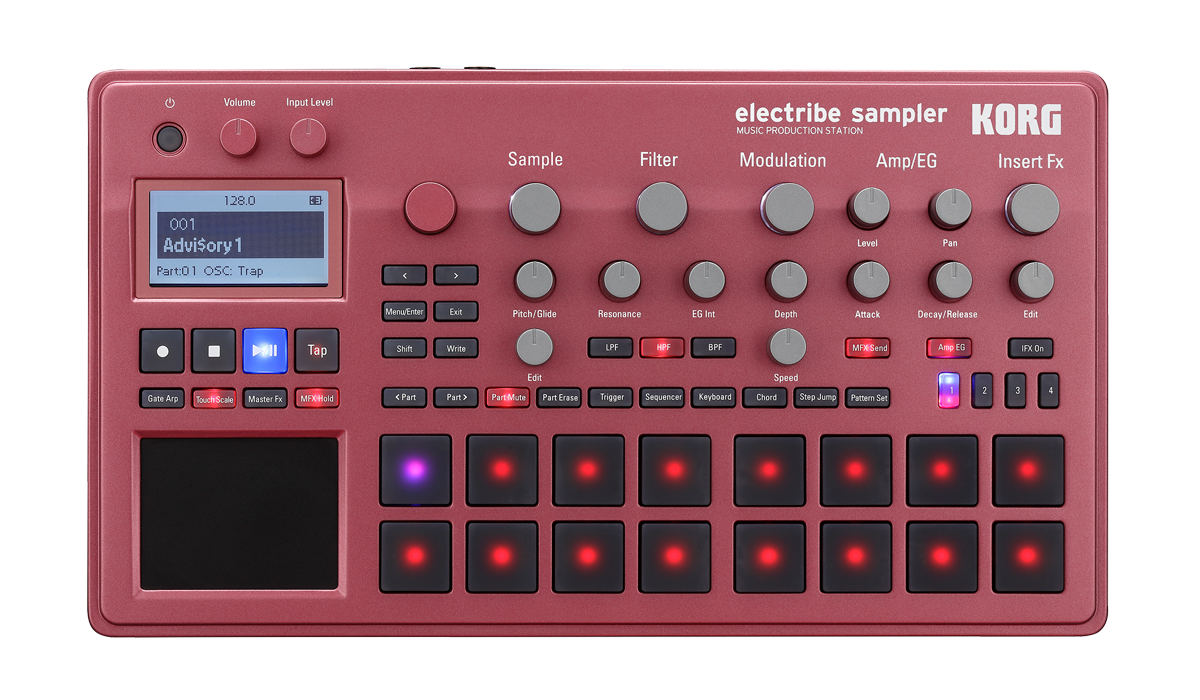
Korg Electribe 2 Sampler
Buy it new on Sweetwater, B&H, Thomann, or Amazon. Look for deals on Reverb.
Korg Electribe 2 Sampler
Starting with the oldest model in this roundup, the Korg Electribe 2 Sampler (known to many as the E2S) is also one of the most affordable at $399. Released in tandem with the Electribe 2 (which doesn’t sample but features a very similar workflow and spec) way back in 2016, these two new Electribes were the long-awaited sequels to the much-loved “original” Electribes, the ESX and EMX of the late ’90s.
The new E2S features 24-voice polyphony per pattern and 16 velocity sensitive pads, laid out in an 8 x 2 grid. The E2S can hold up to 999 samples on an SD card, with a total maximum sample time of 270 seconds. Each track features a multimode filter, one modulation source and destination, an insert effect, and a full ADSR envelope. There’s also the ability to apply a master effect to the entire output.
Pros:
The Electribe 2 is a highly portable machine, as battery power is possible with 6 AA batteries. Overall, the sound is crisp and flexible. The included Kaoss X-Y pad gives hands on control to one of the many 38 effects onboard, which is unique. Effects can also be applied to incoming audio, making the Electribe 2 a possible centerpiece for your live set.
There are a few other nice performance functions—the sixteen pads or the X-Y pad can also be used to play notes in key and arpeggios. Furthermore there’s a Step Jump Function, where only the held down steps will play, a feature that eventually found its way to the Volca series.
The Electribe 2S features an Ableton Live export mode. Using this feature, the Electribe will automatically bounce down all of the tracks to audio and create an Ableton session with the included audio. This makes moving from the Electribe to finishing touches in Ableton fairly painless.
Cons:
The hardware connections are a bit on the limited side, as there’s only a stereo master output, a headphones output, and an audio input on ⅛” jack. Similarly, the screen feels a bit dated by 2022 standards. The plastic feel of the case also feels a bit cheap compared to some of the other entries in this list.
Despite the knobby interface, the workflow could be more intuitive as well. Some users might find that the sonics of the Electribe are slightly dated, which isn’t surprising given its age in the current marketplace. However, given its price, the Electribe is a great starting point for producers wanting to engage in a different workflow.
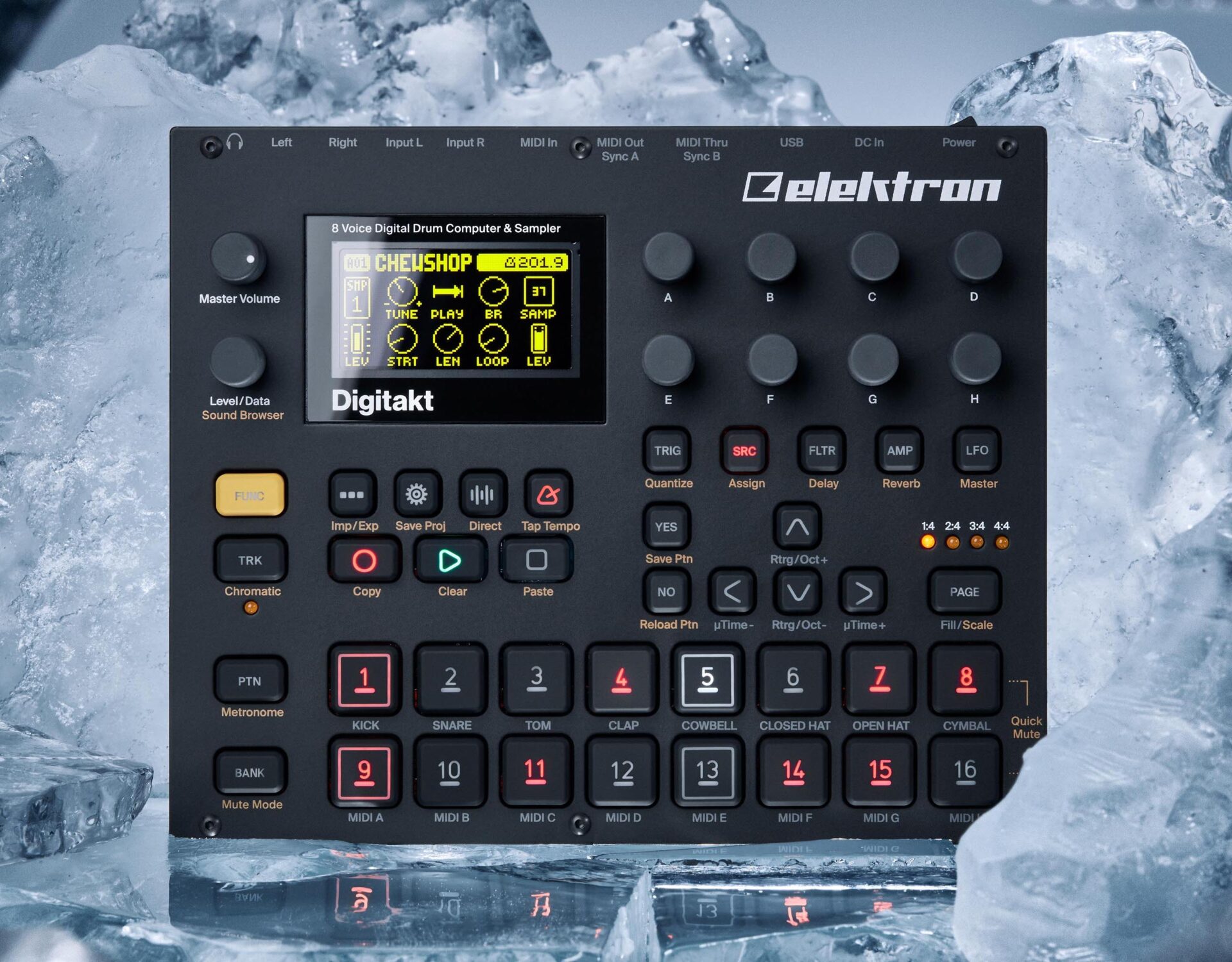
Elektron Digitakt
Buy it new on Sweetwater, B&H, Thomann, or Amazon. Look for deals on Reverb.
Elektron Digitakt
The Elektron brand has mostly been known for its premium offerings, but that all changed in 2017 with the introduction of the Digitakt, which retails at $799. The Digitakt is an eight-track “drum computer” and sampler that features patterns that can be up to 64 steps long. Each pattern is held within a project, with each project holding 128 patterns.
Each of the Digitakt’s eight tracks are monophonic and yet feature all you’d need from a sampler—ADSR envelopes for both the filter and amplitude, a filter with a number of options, an overdrive and bit-reduction effect per track, an LFO with a multitude of shapes and destinations, and a send to a global delay and reverb.
Furthermore, the Digitakt features Elektron’s renowned sequencing workflow, where each step can be “parameter locked” to include its own set of values, independent from the track it’s on. There are also eight MIDI tracks to sequence your external gear, each of which can make use of those same sequencing tricks. If this wasn’t enough, the Digitakt can process external audio through it’s inputs, making it a convenient all-in-one centerpiece for your studio.
On the sampling side of things, the Digitakt can hold 64 MB of RAM; each project can load 128 samples into that RAM at a time. There is a large 1 GB internal drive to store samples, patterns, and projects.
Pros:
The Digitakt is a very solid feeling box that can endure stage use and travel, especially with a Decksaver. It has a great, flexible sound engine that can go from crispy clean to very dirty. Adding to its strength is the Elektron sequencer (both for internal sounds and for other MIDI instruments), with probability and the ability to have each step be its own unique sound with its own settings. The inclusion of a master compressor, mixer page, and the ability to process external audio through its internal effects means the Digitakt is an ideal choice for live use.
Furthermore, the Digitakt is “Overbridge enabled”, so interfacing with your DAW is painless and greatly increases the amount of things Digitakt can do in a recording environment.
Cons:
There’s no song mode on the Digitakt, much to the chagrin of many users, so the only way to chain patterns together is using temporary pattern chains that are lost upon powering down. Sampling is also done in mono, so those nice stereo spreads will be lost. You could also argue that the Digitakt’s performance features are fairly limited. While there is a Fill mode and a Control All setting in which all tracks are affected at once, there’s little else to do while a pattern is running to change its overall composition and sound. And seasoned users of the Digitakt will also be quick to tell you that there’s no time-stretching of loops, so using full loops with the Digitakt is tricky.
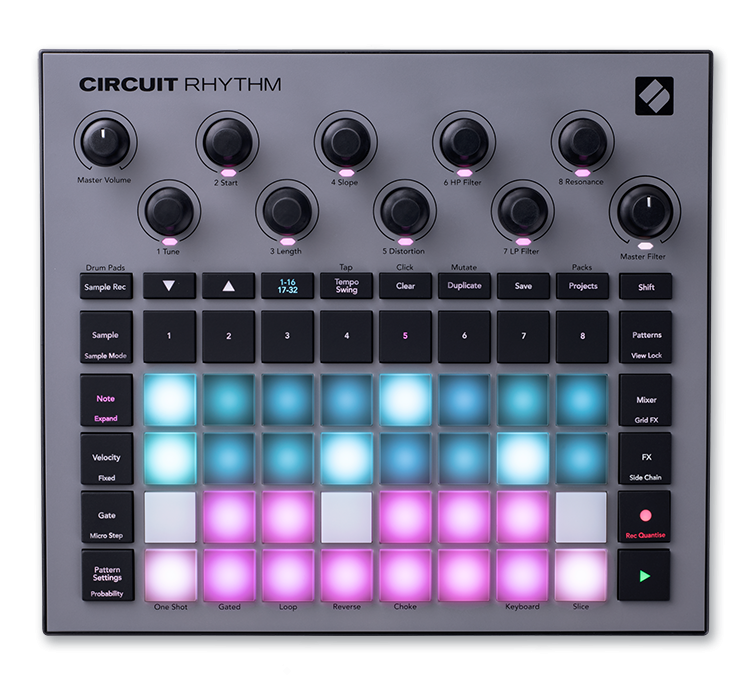
Novation Circuit Rhythm
Buy it new on Sweetwater, B&H, Thomann, or Amazon. Look for deals on Reverb.
Novation Circuit Rhythm
Like the Electribe mentioned above, Novation’s Circuit Rhythm is really a V2, as it is a reboot of the original Circuit, albeit split into a sampler/synth dichotomy again, this time called the Circuit Rhythm and Circuit Tracks, respectively. Given that the Rhythm is more sample-focused, we’re focusing on it for this roundup.
The Circuit Rhythm is yet another sampler with eight, monophonic tracks, MIDI sequencing, and a range of effects (a pattern is starting to emerge…) On the hardware side, the Circuit Rhythm is in a lightweight, portable case, yet feels sturdy enough to bang on the pads. Those pads are arranged in a 4 x 8 grid, and while they are small, they’re still velocity sensitive. The rear of the unit features full-size inputs and outputs, as well as MIDI in/out/thru on full-size jacks.
Samples are loaded via a Micro SD card; there are 128 sample slots per project with a total maximum sampling time of 32 seconds.
The biggest difference in the hardware compared to some of the other contenders in this list is the lack of a screen on the Circuit Rhythm. Because of this, there is precious little menu diving and most things are easily accessed. However, it does mean that some functions are relegated to shift-button press combinations.
Pros:
Like the Electribe, one of the best pros of the Circuit Rhythm is its affordability! It’s also a fairly capable machine in a live environment, as the built-in Grid FX offer a quick way to perform on the Circuit Rhythm, though it would be nice if there was more flexibility in editing them outside of Novation’s app. At the end of the signal chain, Novation has included a built-in Master filter with both low and high pass modes which sounds quite good. The Circuit Rhythm also has a built-in battery, making it extremely portable. And the inclusion of full-size output jacks as well as full-size MIDI jacks make it easy to interface with other gear in the studio.
Cons:
As mentioned, the lack of screen will take a bit of getting used to, so memorization is key to remember where your samples are stored, and which pattern is where. Some users may also note that the pads feel a bit flimsy to the touch compared to some of the other options in this roundup.
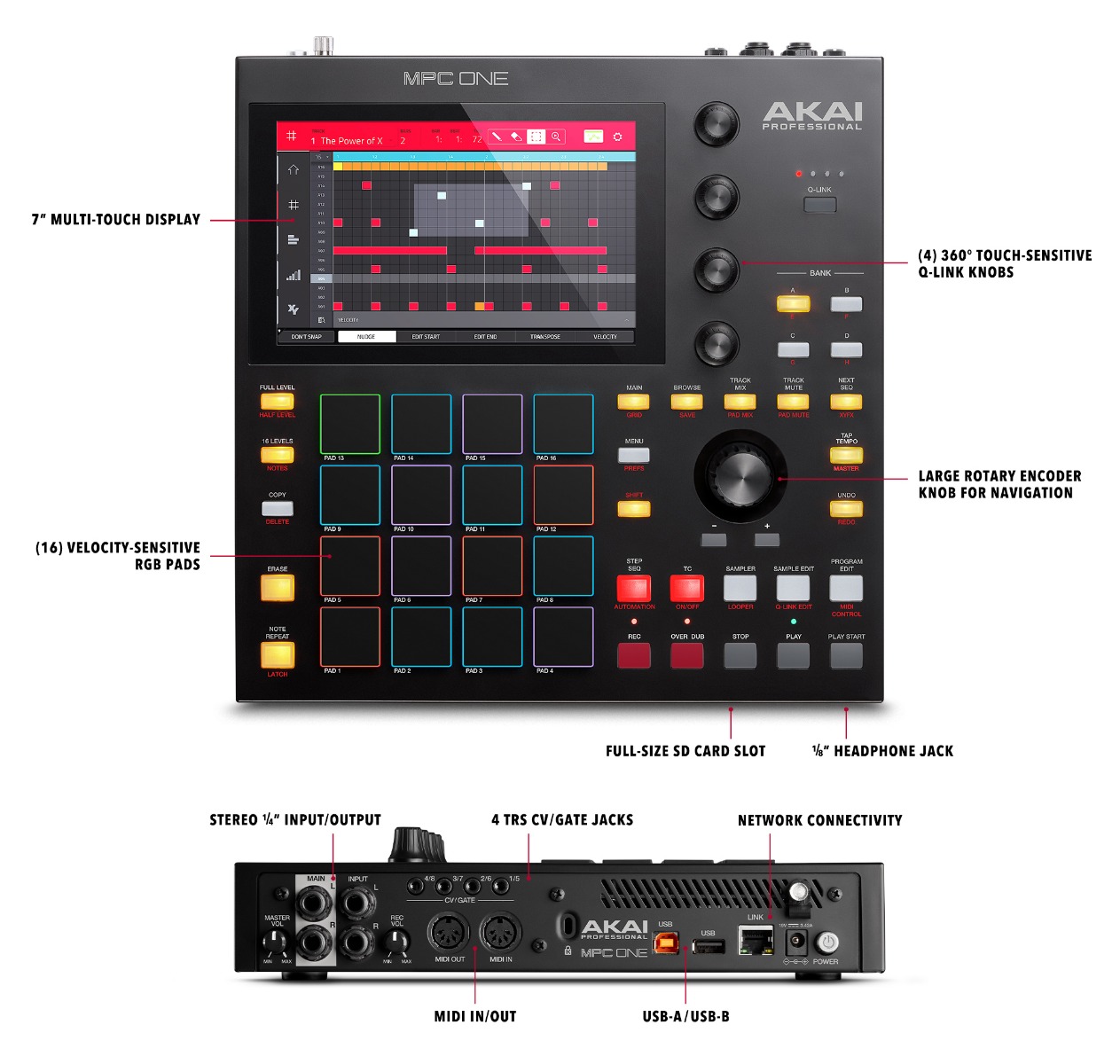
Akai MPC One
Buy it new on Sweetwater, B&H, Thomann, or Amazon. Look for deals on Reverb.
Akai MPC One
Akai is the longest player in the groovebox game, as its iconic MPC line stretches back to 1979 with the Roger Linn-designed MPC-60. Since then, MPCs have been used in every genre imaginable. The most recent lineup features the MPC One, the least expensive of the line of standalone grooveboxes, coming in at $899. The MPC is similar to some of the entries in this list in terms of its hardware features—stereo inputs and outputs, one set of full size MIDI jacks, and four endless encoders. However, there is also a 7″ touchscreen as well as a plethora of custom function buttons. Some may see this as both a boon and a crutch, as the workflow is thus more complicated compared to that of a more streamlined UI.
Things get even more complex when you look inside the box and realize what the MPC One has to offer—sampling, in full stereo glory, and up to 5 minutes at a time. The MPC One can also run software instruments and plugins, of which there are a plethora available. Some of these rival the VSTs you’d find in a comparable DAW, which brings us to MPC’s own MPC Beats platform. While the MPC can run on its own in standalone mode, it can also work in whats called Controller Mode, controlling the software that runs on your computer.
Pros:
The MPC One is an incredibly powerful groovebox with the ability to chop samples, sequence external gear, and run its own internal instruments. There are loads of effects, with the ability to put four effects on each track, plus the master output effects. You’re also not limited by a set number of measures or steps like the other entries in this list. Furthermore, samples can be either mono or stereo, again setting it apart from other choices. And the ability to store samples on an SD card or external hard drive means nearly infinite storage space.
Cons:
Workflow can often be a bit confusing and not intuitive given that there are so many options, choices, and ways to do things on the MPC One. There are also limited ins and outs on the MPC One compared to its bigger brothers, and not everyone will be a fan of the touchscreen. Lastly, there are only four Q-link knobs, so even with a lot of buttons, there is still not a ton of hands on control compared to some of the less expensive entries in this roundup.
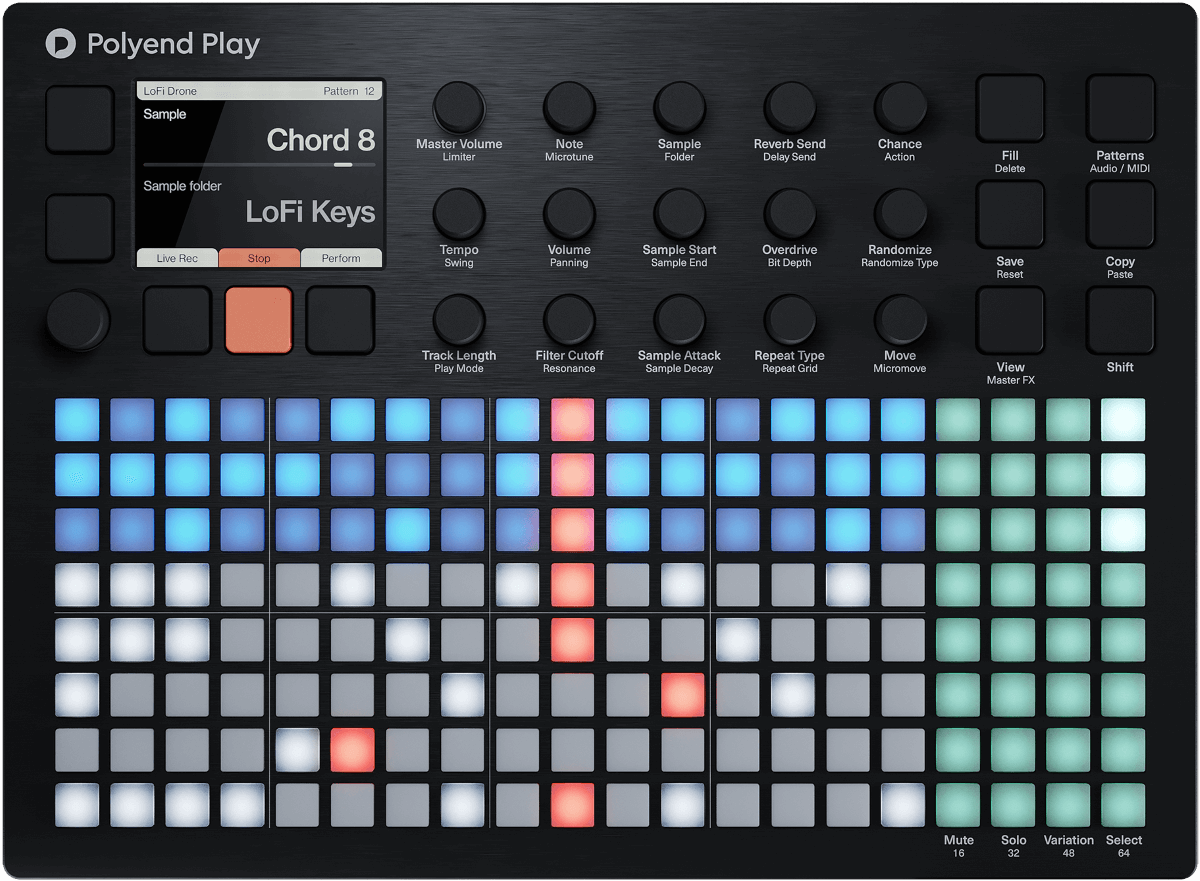
Polyend Play
Buy it new on Sweetwater, B&H, Thomann, or Amazon. Look for deals on Reverb.
Polyend Play
Polyend is the latest upstart in this category, given that the Polish company was founded in 2017 and has only released a few products so far. However, the Play, which was released in May 2022 with the MSRP of $799, has quickly earned a place on this list for its unique approach to sequencing.
The hardware itself is a rather sleek and slim design, partially due to Polyend relying on using ⅛” stereo jacks for the audio output and MIDI connections. While the Play is a sampler, it doesn’t allow onboard sampling, so you’ll have to get samples onto it via a mini SD card, which fits in a slot on the back. The unit is powered via USB C and thankfully seems to last forever when running on a power bank.
Like the Digitakt, the Play features eight monophonic sample tracks, as well as the ability to sequence external MIDI gear. It also uses a similar “parameter locking” system as the Digitakt, with even greater flexibility as to where samples can be placed on its grid.
The Play’s user interface is a bit different from the other grooveboxes we’ve seen in that it makes extensive use of a pad grid that stretches 20 x 8. This grid can show the step sequence information for all eight tracks at once, making it easy to visualize your pattern. Where the Play distances itself from its competitors is the variety of play modes each track can have (35 in total), as well as its unique approach to auto-filling / mangling your patterns with its Euclidean and Randomized sequence modes.
Pros:
The Play features a very flexible and intuitive sequencer with polyrhythmic possibilities and a variety of play modes that immediately make the Play stand out. The Performance mode on the Play is also very unique, as it gives users the ability to add momentary effects to a selection of tracks or just the master output. These range from low and high pass filter effects, specific reverb and delay settings, to beat repeat and rearranger effects. These performance tools help get a lot more mileage out of a single pattern.
Cons:
The Play’s feature set is fairly limited on the hardware side, as there is no audio input of any kind, so no sampling on the machine itself. There are also no full ADSR envelopes, no tweakable effects, and no LFO’s of any kind, so the sound design capabilities are far more limited than some other machines. Samples are also mono and in 16 bit on the Play. And finally, there’s a limited total sample time of about 6 minutes per project, which will be plenty for some and paltry for others.
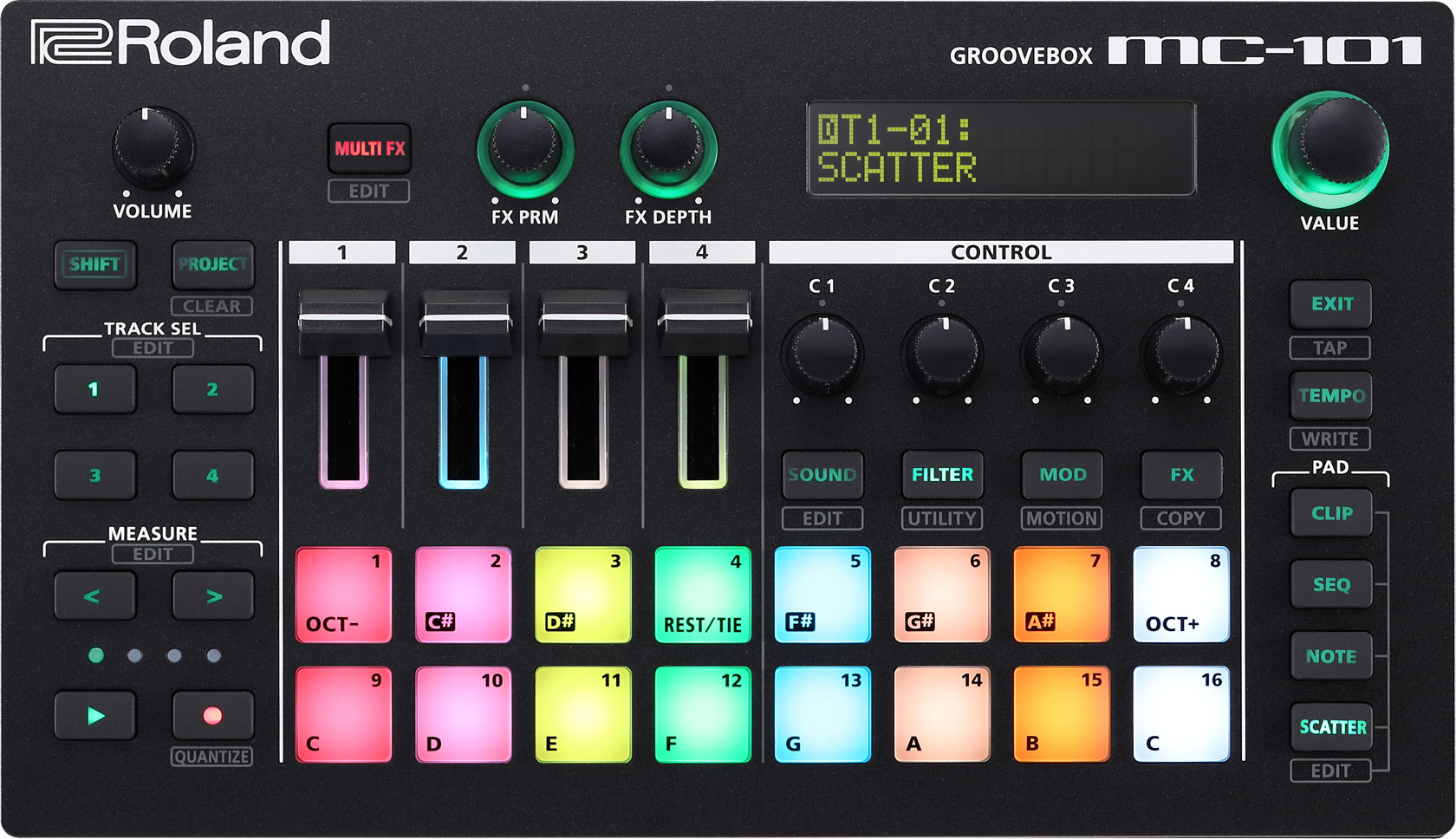
Roland MC-101
Buy it new on Sweetwater, B&H, Thomann, or Amazon. Look for deals on Reverb.
Roland MC-101
Last, but certainly not least, is Roland’s own entry into the groovebox category, the MC-101—a machine that has been out since 2019. The MC-101 shares the same internal architecture as its larger sibling the MC-707 but pares down to four tracks and a much smaller device that is battery powered and very portable. Each track can function as a drum track, a “tone” track that holds one of several thousand synth sounds (as well as a number of more realistic tones), or a looper track, which essentially holds a piece of audio and plays it in loop form, albeit with a few simple controls.
The MC-101 features four sturdy faders for immediate volume control of each of the four tracks, as well as four knobs underneath the two line display that can either control one parameter for each track or focus on one track individually. There are also multi-effects for each track, as well as EQ, compression, and a multi-effect on the master output. Furthermore, there’s a global delay and reverb that each track can be sent to.
The sound engine behind the MC-101 is the same one used in Roland’s Fantom synthesizer; its called Zencore and also has a plugin component that can be used to craft sounds and then port them to the MC-101 via SD card. Importantly, the MC-101 can send audio from each of its tracks and the master output digitally via USB, making multi-tracking a breeze over a single USB cable. Full size MIDI DIN ports and a full size ¼” stereo output make interfacing with other pro gear a breeze as well.
Like a few other machines in this list, Roland has continued to update the MC-101 with a few much-requested features, including the ability to now fully edit synth patches on the machine itself.
Pros:
The built-in Zencore Roland sound engine sounds fantastic, with presets from the Juno, Jupiter, and JX-3P instruments, as well as many, many more sounds. The inclusion of all the Roland TR drumkits, ready to go, is invaluable as well. Running on battery power (or USB power bank) makes the MC-101 incredibly portable and easy to use just about anywhere. It’s also incredibly lightweight while still feeling robust. Full multi-tracking audio over USB is a godsend and makes this groovebox much more than just a sketchpad, as full arrangements can be made in your favorite DAW using the MC-101 as a sound source and brainstorming tool.
Cons:
Some users might wish for a more updated screen in this world of OLED competitors, which is a valid complaint. Only four tracks is going to feel very limited to those used to the unlimited track count of a DAW. And, finally, lack of full hands-on control does mean the sound design capabilities in the live capacity are going to be somewhat limited.
Leo Maymind is a producer, DJ, and writer living in Los Angeles, CA. He is obsessed with sound, and you can reach him at lmaymind@gmail.com.
Please note: When you buy products through links on this page, we may earn an affiliate commission.







[…] Source link […]